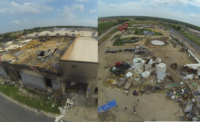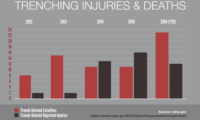A Confined Space blog post
West Texas explosion: Four years later

Posted with permission from Confined Space, a newsletter of workplace safety and labor issues.
(Photo above from CSB.)
Dan Zak of the Washington Post has written a long feature article on the impact and aftermath of the West fertilizer explosion that killed 15 people, injured 252 and damaged or destroyed 500 buildings in the small town of West Texas on April 17, 2013. The article does a great job of describing the impact of the explosion on the residents of West, and has some amazing video of the explosion and its aftermath. What could be improved are the description of the public policy implications of the explosion and articles assumption that the debunked conclusion of the Bureau of Alcohol, Tobacco and Firearms (ATF) that the fire was caused intentionally, was true.
The West Fertilizer Explosion
Some of the descriptions of the explosion and its effect remain chilling to this day. The April 17, 2013 explosion itself was huge: “roughly five times the size of the blast of the 1995 Oklahoma City bombing, which was also generated by ammonium nitrate. It injured almost 10 percent of West’s population, registered as a magnitude-2.1 tremor and flung debris as far as 21/2 miles away. It was as if a twister had come through town carrying an atomic bomb.”
And it was felt far and wide:
Up on the bluff, Bryan’s wife was knocked off her feet. Behind her, the front windows of the house exploded, and glass shards riddled the couch she had just been sitting on.
Across from the apartments, the rest home folded like a house of cards. At the schools, door frames split, ceiling tiles dropped and glass flew into corkboard.
All around West, air bags deployed. Car trunks opened. Tires went flat. Garage doors crumpled out while windows blew in. Insulation dropped from ceilings. Water mains cracked underground.
A mile away at St. Mary’s, the stained glass splintered.
Six miles away, in the town of Abbott, front doors popped open.
Ten miles away, a fisherman on Aquilla Lake ducked, thinking his boat was being struck by lightning.
One tends to focus on the fatalities — and they were tragic. Fifteen people died, including 12 first responders, 5 of whom were members of the West Fire Department. But with so many fatalities, one tends to forget the serious injuries:
“I never knew the body could hold so many tears,” said Doreen Strickland, of the Abbott department.
There were at least 53 people with traumatic brain injuries or concussions. One young man — his face deformed by lacerations when the apartment complex disintegrated — hanged himself from a tree in his yard that October.
| One tends to focus on the fatalities — and they were tragic. Fifteen people died, including 12 first responders, 5 of whom were members of the West Fire Department. But with so many fatalities, one tends to forget the serious injuries. |
The Cause of the Fire
One of the things that burns me most about this story is the assumption that the ATF finding was correct – -that the fire was intentionally set. The ATF put an enormous amount of work into finding the cause of the fire. The ATF team “was on the scene for 29 days, sorting through obliterated machinery for evidence, conducting 400 interviews, even combing through 300,000 pounds of corn from a demolished silo at the plant. It was one of the largest investigations ever undertaken by the ATF.”
And Zak explains how the ATF came to that conclusion over three years after the explosion:
Through this process, they ruled out the weather.
They ruled out a cigarette.
They ruled out faulty wiring.
And then, on May 11, 2016, more than three years after the explosion, investigators held a news conference in West.
“The fire has been ruled as incendiary,” an investigator said.
That meant someone set it.
Well, no it didn’t, as Confined Space and the Houston Chronicle and Waco Tribune Herald have already explained. To repeat:
Happily, the citizens of West didn’t seem to take the ATF finding too seriously:
Finally, West had been given a sign that might help explain the inexplicable — but it wanted little to do with it.
The ATF’s announcement managed only to rip the scab off the wound, trip up the lawsuits and inspire a tremor of suspicion — much of it directed at the ATF. West was not on board for a whodunit, especially if there appeared to be no leads. The town had already spent years processing the blast, and it had arrived at something other than anger or blame.
| What started the fire wasn’t as important as the conditions that allowed a fire (whatever caused it) to become a catastrophic explosion. |
And, of course, ultimately, what started the fire wasn’t as important as the conditions that allowed a fire (whatever caused it) to become a catastrophic explosion. That’s where the focus needs to lie: on how to prevent catastrophic explosions — and what public policy initiatives can get us there.
Public Policy
The disaster impacted the country like no other (non-coal mine related) workplace disaster in memory — perhaps because it wasn’t just a workplace disaster — it was a community catastrophe. President Obama spoke at the funeral, and on August 1, 2013, as a result of the West explosion and other recent chemical plant incidents, issued Executive Order 13650 “Improving Chemical Facility Safety and Security.”
Regulatory Modernization
Among other things, the EO told OSHA and EPA to develop a plan to implement “improvements to existing risk management practices through agency programs, private sector initiatives, Government guidance, outreach, standards, and regulations.” As a result, OSHA began the long process of updating its Process Safety Management (PSM) standard that had been issued in 1992. EPA committed to updating its parallel Risk Management Program regulation.
EPA’s sliced off some of the more manageable parts of its RMP regulation to update, and being as their regulatory process is significantly more streamlined than OSHA’s, EPA issued its revised RMP regulation in the waning days of the Obama administration. EPA’s new rule significantly improved communication between facilities and emergency responders, clarified information that emergency responders need to safely respond to incidents, required root cause analyses of chemical plant incidents and near misses, and required chemical facilities to consider “inherently safer” chemicals and production processes.
Communication between facilities and emergency responders — about what’s in the facility and how to deal with emergencies like spills and fires — would have been a key to preventing the deaths of the responders. But last June, bowing to chemical industry pressure, EPA administrator Scott Pruitt announced that he would delay implementation of the updated Risk Management Protection until February 19, 2019. The delay was needed “to allow the agency to conduct a reconsideration proceeding and to consider other issues that may benefit from additional comment.” Part of the reason that the Agency allegedly needed “additional comment” was because of the late breaking conclusion by the ATF that the fire was caused intentionally. In other words, Pruitt’s pretext for delaying the rule was largely based on on the completely unsubstantiated 2016 allegation by the Bureau of Alcohol, Tobacco and Firearms (BATF) that the fire at West Fertilizer was caused by arson. That allegation raised security issues, which then raises questions about whether enhanced communication between chemical facilities and first responders is a good idea — worker and community safety be damned.
Retail Exemption
The President’s Executive Order also told OSHA to identify any changes that needed to be made in the “retail exemption” to the PSM standard. What was the retail exemption? The PSM standard exempts “retail facilities,” but does not define what it means by a “retail facility.” The preamble to the standard suggested that OSHA intended the retail exemption to cover facilities that sold small packages of chemical like gas stations or hardware stores, but shortly after the PSM standard was issued, OSHA issued an “interpretation” defining a retail establishment as one that sold more than 50% of its highly hazardous materials to “end users.” So no matter how much of a hazardous material a plant stored, if more than 50% was sold to farms, the facility was exempt from PSM. Under that definition, West was a “retail facility.”
OSHA had not inspected West since the 1980’s. Although OSHA had implemented a chemical facility National Emphasis Program, West was not included because it fell under the PSM standard’s “retail exemption.” The 300,000 pounds of ammonium nitrate stored at the facility would not have brought OSHA to the plant under the chemical facility NEP because ammonium nitrate is not covered by PSM — a problem that EPA postponed and that OSHA will consider as it re-examines its PSM standard.
But West did have tens of thousands of gallons of another highly hazardous chemical on the premises that would have been covered by PSM and would have put West into the Chemical Facility NEP — two storage vessels containing anhydrous ammonia. Luckily, these tanks suffered little damage and only a small amount of leakage as a result of the explosion. Had the facility been covered by PSM, and fallen under the NEP, and had OSHA inspected the facility, it’s likely they may have also identified the problems with the facility’s storage of ammonium nitrate.
In 2015 OSHA clarified the definition of retail to bring it into compliance with the original intent of the standard. Facilities like West would then be covered by PSM. To make a long story short, however, the agricultural retailers and the agriculture industry in general strongly opposed OSHA’s new interpretation and got Congress to prohibit OSHA from enforcing it. They also sued and a court overturned OSHA’s interpretation stating that the agency would have to go through years of full rulemaking to ensure that facilities like West were covered by PSM.
Other Issues
Zak also raises one additional issue that has not been addressed by any government agency: Facility siting.
The rest home, which had been evacuated, was destroyed, as was the apartment complex where two people died. Because the explosion happened at night, no one was on the playground or basketball court.
But Zak notes that West was not the only town in Texas — or across the United States — that is threatened: “19 other sites in Texas each continued storing at least 10,000 pounds of fertilizer-grade ammonium nitrate within a half-mile of a school, hospital or rest home. At least an additional 170 sites held some quantity of fertilizer, many in wood-frame buildings.”
Conclusion
The West explosion was one of the worst workplace and community chemical facility disasters in American history. Although the Executive Order launched a number of measures to address the problems raised by the West explosion and other chemical plant incidents over the past few years, the wheels of government turn slowly, and the safety of the American chemical industry is now in the hands of the Trump administration.
Zak and the Washington Post have done a service to the country reminding people of the serious impact these tragedies can have on workers and communities, and the need to better control the hazards that chemical facilities across the country present.
But to prevent these catastrophes, we also need a public policy apparatus that not only recognizes the root causes of these incidents, but also works to improve the regulatory controls and safeguards that all of us expect to protect us from the “retail facility” down the street. We need a Part 2 of the Posts’s story, that follows up on the government’s and industry’s obligation to take strong — and sometimes unpopular measures — to prevent these incidents and save the brave lives that were lost at West.
Click here to visit Confined Space.
Looking for a reprint of this article?
From high-res PDFs to custom plaques, order your copy today!






